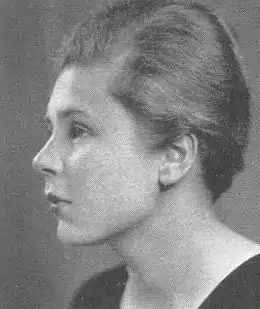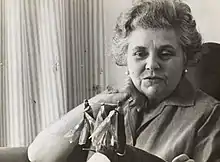Elizabeth Bishop
Elizabeth Bishop ( - ), est une poétesse et femme de lettres américaine originaire de Worcester (Massachusetts). Elle fut Poète lauréat consultant en poésie à la Bibliothèque du Congrès en 1949 et en 1950, lauréate du prix Pulitzer de poésie en 1956, et elle fut membre de l'Academy of American Poets.

| Naissance | |
|---|---|
| Décès |
(à 68 ans) Boston |
| Sépulture |
Hope Cemetery (en) |
| Nationalités | |
| Domiciles | |
| Formation |
Vassar College (- Walnut Hill School (en) Saugus High School (en) |
| Activités |
| A travaillé pour | |
|---|---|
| Membre de | |
| Distinctions | Liste détaillée Bourse Guggenheim () Shelley Memorial Award () Prix Pulitzer de la poésie () Academy of American Poets Fellowship () National Book Award pour la poésie () Neustadt International Prize for Literature () Membre de l'Académie américaine des arts et des sciences Docteur honoris causa de l'université Brandeis National Book Critics Circle Award for Poetry (en) |
| Archives conservées par |
Bibliothèque de l'Université de Princeton[1] University of Delaware Library Special Collections (d)[2] |
One Art (d) |

Biographie
Orpheline, Elizabeth Bishop a vécu chez ses grands-parents en Nouvelle-Écosse dans une maison appelée Bulmer House, une période qu'elle a idéalisée dans ses écrits[3].
Elle entra à l'université de Vassar College à l'automne 1929, peu après le krach boursier. En 1933 elle cofonda Con Spirito, un magazine littéraire subversif à Vassar, en compagnie de la femme de lettres Mary McCarthy, Margaret Miller, et les sœurs Eunice et Eleanor Clark (en)[4].
Bishop était grandement influencée par la poétesse Marianne Moore[5] à qui elle fut présentée par la bibliothécaire de Vassar en 1934.
Randall Jarrell lui présenta Robert Lowell en 1947. Elle écrivit le poème « Visits to St. Elizabeth's » en 1950 comme souvenir des visites qu'elle rendit au poète Ezra Pound. Elle rencontra aussi James Merrill en 1947, et ils devinrent des amis très proches.
En 1946, Marianne Moore poussa Elizabeth Bishop à se présenter au prix Houghton Mifflin de poésie, qu'elle gagna. Son premier livre, North & South, fut tiré à 1 000 exemplaires.

Alors qu'elle vivait au Brésil, Elizabeth Bishop reçut en 1956 le prix Pulitzer de poésie pour son recueil North & South - A Cold Spring. Elle obtint ensuite le National Book Award et le National Book Critics Circle Award. En 1976, elle devint la première femme à recevoir le Neustadt International Prize for Literature, et elle demeure pour le moment le seul citoyen américain à avoir reçu ce prix[6].
Elle écrivit également maints articles pour le magazine The New Yorker, et rédigea en 1964 un hommage posthume à Flannery O'Connor dans la revue The New York Review of Books.
Elle enseigna peu de temps à l'université de Washington, avant d'enseigner à l'université Harvard pendant sept ans. Elle a ensuite enseigné à l'université de New York, pour enfin terminer sa carrière au Massachusetts Institute of Technology.
Elizabeth Bishop mourut en 1979 d'une hémorragie cérébrale dans son appartement à Lewis Wharf (État de Boston).
Son poème « One Art » figure dans le film In Her Shoes quand Maggie, jouée par Cameron Diaz, en fait la lecture à un professeur alité dans un hospice. Ce même poème (qui est une villanelle) a inspiré le titre du roman « L'Art de perdre » d'Alice Zeniter, chez Flammarion, en 2017, et est récité, amputé de ses quatre derniers vers, par le personnage d'Ifren, page 496 de cette édition, la traduction française en était de Alix Cléo Roubaud, Linda Orr et Claude Mouchard aux éditions Circé .
Traductrice
Lors de son séjour au Brésil, Elizabeth Bishop s'intéressa aux langues et littératures d'Amérique latine. Elle traduisit entre autres le poète mexicain Octavio Paz, et les poètes brésiliens João Cabral de Melo Neto et Carlos Drummond de Andrade.
Vie privée
Elizabeth Bishop eut deux histoires d'amour durables. La première avec l'architecte Lota de Macedo Soares[7]. Elles vécurent ensemble une quinzaine d'années. Cependant leur relation se détériora, et Bishop quitta Lota Soares. Cette dernière, souffrant de dépression, rejoignit Bishop aux États-Unis et se suicida[8].
Elle achète une maison à Key West avec la philanthrope new-yorkaise Louise Crane, en 1938[9].
Elizabeth Bishop rencontra Alice Methfessel (1943-2009) en 1971, et cette dernière devint sa compagne et son exécutrice littéraire après sa mort[10].
Œuvres
Poésie :
- North & South (Houghton Mifflin, 1946)
- A Cold Spring|Poems: North & South — A Cold Spring (Houghton Mifflin, 1955)
- A Cold Spring (Houghton Mifflin, 1956)
- Questions of Travel (Farrar, Straus and Giroux, 1965)
- The Complete Poems (Farrar, Straus and Giroux, 1969)
- Geography III, (Farrar, Straus and Giroux, 1976)
- The Complete Poems: 1927-1979 (Farrar, Straus and Giroux, 1983)
- Edgar Allan Poe & The Juke-Box: Uncollected Poems, Drafts, and Fragments, edited and annotated by Alice Quinn, (Farrar, Straus and Giroux, 2006)[11]
Divers :
- The Diary of "Helena Morley," by Alice Brant, translated and with an Introduction by Elizabeth Bishop, (Farrar, Straus, and Cudahy, 1957)
- « Three Stories by Clarice Lispector, » Kenyon Review 26 (Summer 1964): 500-511.
- The Ballad of the Burglar of Babylon (Farrar, Straus, and Giroux, 1968)
- An Anthology of Twentieth Century Brazilian Poetry edited by Elizabeth Bishop and Emanuel Brasil, (Wesleyan University Press (1972))
- The Collected Prose (Farrar, Straus, and Giroux, 1984)
- One Art: Letters, selected and edited by Robert Giroux, (Farrar, Straus, and Giroux, 1994)
- Exchanging Hats: Paintings, edited and with an Introduction by William Benton, (Farrar, Straus, and Giroux, 1996)
- Rare and Commonplace Flowers: The Story of Elizabeth Bishop and Lota de Macedo Soares, by Carmen L. Oliveira; traduit par Neil K. Besner, (Rutgers University Press, 2002)[7]
Récompenses
- 1945 : Houghton Mifflin Poetry Prize Fellowship
- 1947 : Bourse Guggenheim
- 1949 : Appointed Consultant in Poetry at the Library of Congress
- 1950 : American Academy of Arts and Letters Award
- 1951 : Lucy Martin Donelly Fellowship (décerné par le Bryn Mawr College)
- 1953 : Shelley Memorial Award
- 1954 : Elected to lifetime membership in the National Institute of Arts and Letters
- 1956 : Prix Pulitzer en poésie
- 1960 : Chapelbrook Foundation Award
- 1964 : Academy of American Poets Fellowship
- 1968 : Ingram-Merrill Foundation Grant
- 1969 : National Book Award
- 1969 : The Order of the Rio Branco (décerné par le gouvernement brésilien)
- 1974 : Prix Harriet Monroe de la revue Poetry
- 1976 : Books Abroad / Neustadt International Prize
- 1976 : Elected to the American Academy of Arts and Letters
- 1977 : National Book Critics Circle Award
- 1978 : Bourse Guggenheim
Notes et références
- « https://library.princeton.edu/special-collections/collections/elizabeth-bishop-collection »
- « https://library.udel.edu/static/purl.php?mss0103 »
- « Elizabeth Bishop », Worcester Area Writers, Worcester Polytechnic Institute
- « Elizabeth Bishop, American Poet », Elizabeth Bishop Society, Vassar College
- Kalstone, David. Becoming a Poet: Elizabeth Bishop with Marianne Moore and Robert Lowell. University of Michigan Press (2001) : « 4. In an early letter to Moore, Bishop wrote: "[W]hen I began to read your poetry at college I think it immediately opened up my eyes to the possibility of the subject-matter I could use and might never have thought of using if it hadn't been for you. — (I might not have written any poems at all, I suppose.) I think my approach is so much vaguer and less defined and certainly more old-fashioned — sometimes I'm amazed at people's comparing me to you when all I'm doing is some kind of blank verse — can't they see how different it is? But they can't apparently." »
- « ou.edu/worldlit/neustadt/laure… »(Archive.org • Wikiwix • Archive.is • Google • Que faire ?).
- The Love of Her Life by Emily Nussbaum, a June 2002 review in The New York Times of Rare and Commonplace Flowers: The Story of Elizabeth Bishop and Lota de Macedo Soares
- Rare and Commonplace Flowers: The Story of Elizabeth Bishop and Lota de Macedo Soares,, Oliveira, Carmen, Rutgers University Press, (ISBN 0-8135-3359-7), 2002
- (en-US) Mark Hedden, « History Unchanged – The Elizabeth Bishop House on White Street », sur Florida Keys Weekly Newspapers, (consulté le )
- Bold Type: Essay on Elizabeth Bishop
- Like a Jeweled Box Waiting at the Bottom of the Sea: Quinn Offers a New View of Elizabeth Bishop, a review of Edgar Allan Poe and the Juke Box in Moondance magazine June-Sept. 2006
Voir aussi
Bibliographie
- (en) Bonnie Costello, Elizabeth Bishop : Questions of Mastery, Cambridge, Harvard University Press, , 265 p. (ISBN 978-0-674-24689-8)
- (en) David Kalstone, Becoming a Poet : Elizabeth Bishop with Marianne Moore and Robert Lowell, New York, Farrar Straus Giroux, , 1re éd. (ISBN 978-0-374-10960-8)
- (en) Brett Millier, Elizabeth Bishop : Life and the Memory of It, Berkeley, University of California Press, (ISBN 978-0-520-07978-6)
- (en) Elizabeth Bishop, Conversations with Elizabeth Bishop, Jackson, University Press of Mississippi, (ISBN 978-0-87805-871-6)
- (en) Thomas Travisano, Elizabeth Bishop : Her Artistic Development, Charlottesville, University Press of Virginia, , 2e éd., 227 p. (ISBN 978-0-8139-1159-5)
- Alain Suberchicot, The Complete Poems, Elizabeth Bishop, cours de concours, analyse de l'œuvre, précédé d'une introduction méthodologique de Patrick Chézaud, coll. Amphi dirigée par Patrick Chézaud et Martha Dvorak, Bréal, , 105 p. (ISBN 978-2-7495-0075-1)
Cinéma
- 2013 : Reaching for the Moon de Bruno Barreto sur la relation d'Elizabeth Bishop et Lota de Macedo Soares.
- 2015: Welcome To This House, documentaire de Barbara Hammer.
Liens externes
- Ressources relatives à la littérature :
- (en) Academy of American Poets
- (en) London Review of Books
- (en) The Paris Review
- (en) Poetry Archive
- (en) Poetry Foundation
- (en) Poetry International Web
- Notices dans des dictionnaires ou encyclopédies généralistes :
- Elizabeth Bishop à Vassar College
- Paper Trail un entretien de 2006 avec Alice Quinn dans The Atlantic Monthly